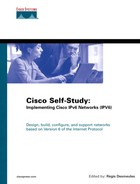Cisco Express Forwarding for IPv6
Cisco Express Forwarding (CEF) is a Layer 3 switching technology designed for routers. It uses a method that optimizes route lookups to achieve very fast forwarding. CEF uses two tables to store the information needed for routing: the Forwarding Information Database (FIB) and the adjacency table.
NOTE
CEF is supported on routers 1700, 2600, 3600, 3700, 7100, 7200, 7400, 7500, 7600, and the Catalyst 6500 and 12000 series.
Central CEF— The route processor handles CEF and adjacency tables. This mode is supported on router series 1700 to 7500.
Distributed CEF (dCEF)— This mode is used on distributed hardware architectures such as the Cisco 7500 VIP and Cisco 12000 line cards. dCEF performs the express forwarding of packets between port adapters and uses interprocess communications (IPC) to synchronize the CEF FIB and adjacency tables between router processors and linecards. The dCEF mode is supported on router series 7500 and 12000(GSR).
CEFv6's behavior is the same as CEF for IPv4. CEFv6 has new configuration commands, and CEFv6 and CEF for IPv4 have some of the same commands. This section presents the new commands used to manage CEF for IPv6 networks.
Enabling CEFv6 on Cisco
CEFv6 is available on Cisco IOS Software 12.2(13)T and above and 12.2(9)S and above. dCEFv6 is available on Cisco IOS Software 12.0(21)ST1, 12.0(22)S and above for the Cisco 12000 series, and 12.2(13)T for the Cisco 7500 series.
The ipv6 cef command enables the central CEFv6 mode. However, before you enable CEFv6, you must enable IPv4 CEF using the ip cef command. Similarly, you must enable IPv4 dCEF using the ip cef distributed command before you enable dCEFv6 with the ipv6 cef distributed command.
show Commands for CEFv6
You can display IPv6 information related to CEFv6 using the show ipv6 cef and the show cef commands. Table 4-14 shows the options and parameters of the show ipv6 cef command.
debug Commands for CEFv6
You can debug CEFv6 using the debug ipv6 cef command. Its options and parameters are shown in Table 4-15.
